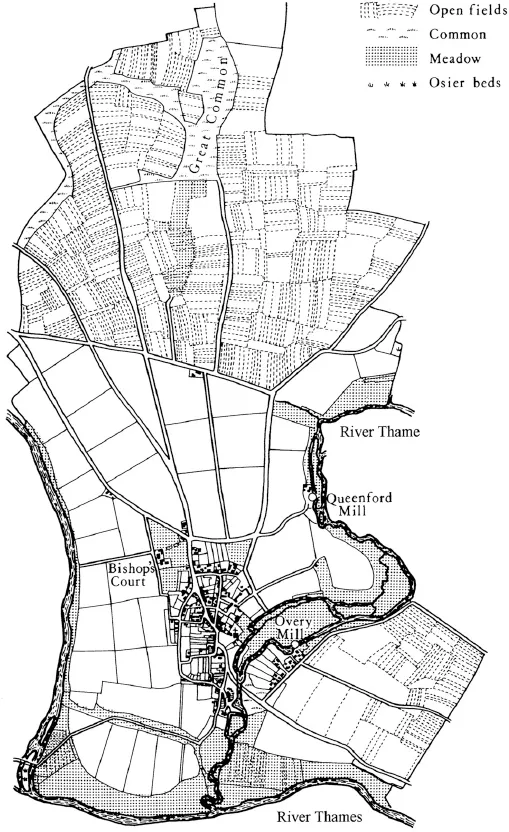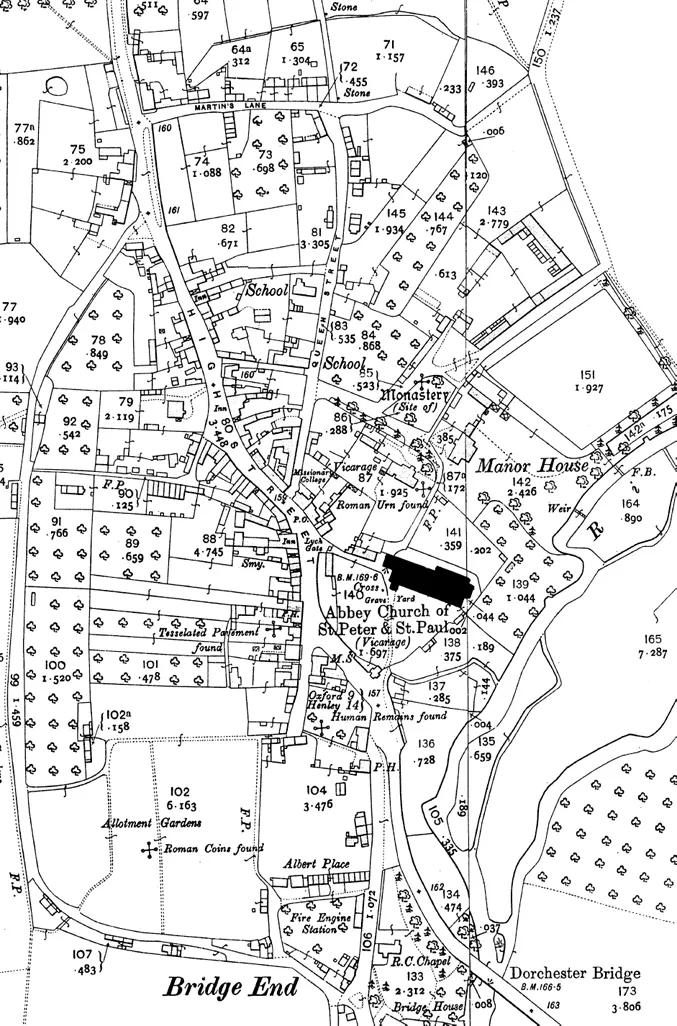![]()
PART I: ARCHAEOLOGY, ARCHITECTURE AND CONTEXT
CHAPTER 1
The Antiquarian Background
The substantial Oxfordshire village of Dorchester-on-Thames, together with its immediate environs, is one of the archaeologically most complex and interesting areas in Britain. There is not just something illustrative of every period in history, but an abundance of material evidence of high-ranking importance.1 The early prehistoric era is principally represented by the Dorchester cursus, a henge monument and tumuli; and the riverside fortification of Dyke Hills is an important monument of later prehistory. In the early Roman period there was a fort guarding the crossings of the rivers Thames and Thame, and this was later superseded by a small walled town. The area remained densely settled in the early Anglo-Saxon period, and some outstanding finds have been made, particularly from pagan cemeteries. However, Dorchester’s greatest claim to fame is arguably in the middle Saxon period, when it became the seat of a huge bishopric, which initially extended from Dorset to the south Midlands; a later redefinition of the diocese retracted its southern territory but took its northern limit to the Humber. The founding bishop (later saint) was Birinus, whose name has been firmly associated with Dorchester since A.D. 635. Unlike many Anglo-Saxon cults which fizzled out and were never rekindled, that of St Birinus not only survived the Norman Conquest, but continued to flourish until the Reformation.
When Dorchester lost its diocesan status to Lincoln in the late 11th century, it remained a local market town, and the former cathedral became a church of secular canons, who, in the mid-12th century, were superseded by Augustinian canons. Although Dorchester Abbey was neither large nor rich, it nevertheless flourished in unexpected ways, and most notable amongst its surviving treasures is the unique suite of windows installed at the east end of the church in the early 14th century. Inevitably, the abbey was suppressed at the Reformation, but the church survived almost in its entirety, and stands today as one of the larger and more remarkable ex-monastic parish churches in England. The town, meanwhile, declined as an urban focus, to be transmuted into an attractive village replete with many fine historic buildings. The history and topography of the Dorchester region has justly attracted much attention from antiquaries. Nevertheless, considerable areas of uncertainty remain, some of which can only be remedied by large-scale archaeological excavations.
The topographical situation of Dorchester is particularly favourable to both settlement and defence. The site lies at the confluence of the Thames and Thame, on a roughly rectangular promontory of gravel, over which is a thin capping of brickearth (Fig. 1).2 The west and south sides of the promontory are formed by a right-angled bend in the Thames, and the east side by the Thame. The Roman and medieval town grew up alongside the latter river, and thus the designation ‘Dorchester-on-Thames’ is somewhat misleading. However, the Thames was a major artery of communication, and in the Middle Ages it was navigable as far as Oxford. The main overland route through Dorchester runs from north-west (Oxford) to south-east (Wallingford), and there is a bridge over the Thame at the southern end of the town (Figs 2 and 3).
FIGURE 1: The parish of Dorchester and topography of the promontory between the rivers Thames and Thame, c. 1840. (Cook and Rowley, 1985)
FIGURE 2. Dorchester-on-Thames: Ordnance Survey 1:2,500 map, 1910 edition. Reduced to 1:3,250 scale.
FIGURE 3. The environs of Dorchester Abbey, highlighting the principal buildings discussed in the text.
The principal disadvantage of the locality is the lack of good building stone: hence timber and cob have always been the major structural materials, later followed by brick. Chalk was available from the Sinodun Hills (Wittenham Clumps), just south of Dorchester, together with flint nodules that are found in association with the chalk; both materials were pressed into service by builders. For good quality masonry, however, oolitic limestone had to be transported from quarries on the Oxford Heights, several kilometres to the north. The abbey church is built mainly of rough limestone rubble, with finely dressed ashlar reserved for quoins and mouldings.
EARLY DESCRIPTIONS OF DORCHESTER
The earliest recorded description of Dorchester is by the chronicler William of Malmesbury who, in c. 1125, referred to the town as ‘obscure and unfrequented’, but commented on its churches as remarkable for their beauty.3 In 1340, another chronicler, Ranulf Higden, commented on Dorchester in his Polychronicon.4 Although William Worcestre evidently called at Dorchester whilst on his itineraries in 1480 he did not dally,5 and the earliest topographical description of the place was not penned until 1542 by John Leland. He described the town briefly:
The toun of Dorchestre was sore defacid by the Danes. Of old tyme it was much larger in building then it is now toward the south and the Tamise side. There was a paroche chirch a litle by south from the abbay chirch. And another paroch chirch more south above it. There was a 3 paroch chirch by south weste.
In the closis and feeldes that lye southly on the toun that now standith be founde numismata Romanorum of gold, silver and brasse.
The bisshop’s palace, as is saide the[re], was at the toune’s end by north west, wher yet appere fundations of old buildings; and there as yet be kept the courtes.
The abbay of chanons, wher afore the Conquest was a bisshopes sete. Remigius translatid it to Lincoln. Alexander Bisshop of Lincoln erected there an abbay of blak chanons. Yet the chirch berith the name of the prebend chirch. There was burid, as it is said, the bodie of S. Birine bisshop there.6
FIGURE 4. Annotated sketch plan of Dorchester church by Anthony Wood, shortly before 1657. East is at the top. (Clark, 1891)
Leland went on to list features within the abbey – mostly tombs – that captured his attention.
Visitors who were principally interested in heraldry have left behind their notes, including Richard Lee and Robert Cooke (Clarenceux King of Arms) in 1574,7 Nicholas Charles (Lancaster Herald) and Francis Thynne, in 1596–97,8 and Richard Symonds, in 1644.9 In the 17th century, a remarkably full description of Dorchester Abbey was contained in the manuscript notes of Anthony Wood, the Oxford antiquary (1632–95).10 He visited the church in August 1657, noting, inter alia:
The church is larg and antique, and hath contained many monuments of antiquit...




